Physical Address
304 North Cardinal St.
Dorchester Center, MA 02124
Conjunctivitis is an inflammation of the conjunctiva that can manifest in both an acute and chronic form (persisting for 4 weeks or more). The etiology of the inflammation can include allergic, infectious (bacterial, viral, protozoal, parasitic), autoimmune, or autoreactive.
Conjunctivitis typically involves erythematous changes to conjunctiva, which may be accompanied by chemosis, discharge or membranes. Depending on the etiology, the conjunctiva can present with a papillary (micropapillae with central vessels) or follicular reaction (slightly elevated, discrete, hypopigmented lesions with overlying or peripherally displaced vessels). Conjunctival inflammation can lead to a disturbance of the tear film and concomitant keratopathy (keratoconjunctivitis). In severe cases, conjunctival cicatrization and fibrosis can result in architectural changes to the fornix and eyelid.
A conjunctival biopsy is often not needed but can be useful in characterizing conjunctivitis and distinguishing it from neoplastic disorders. As with any inflammatory process the density, composition, and proportion of the inflammatory cells (lymphocytes, neutrophils, eosinophils, histiocytes, plasma cells) varies depending on the time course (early versus late), activity (acute versus chronic) and nature of the process (allergic versus infectious versus other). A suppurative neutrophil-rich infiltrate is typical of an acute bacterial infection, but lymphocytes and plasma cells are commonly seen in chronic conjunctivitis ( Fig. 19-1 ). Chronic irritated lesions often display squamous metaplasia of the surface mucosa ( Fig. 19-2 ). On occasion, a conjunctivolith may be seen in the mucosa ( Fig. 19-3 ). A high number of eosinophils suggest an allergic hypersensitivity reaction. Except for the identification of an infectious organism, foreign body, or ruptured cyst, the cause of conjunctivitis can usually not be deduced from the histologic findings and depends on clinical correlation.
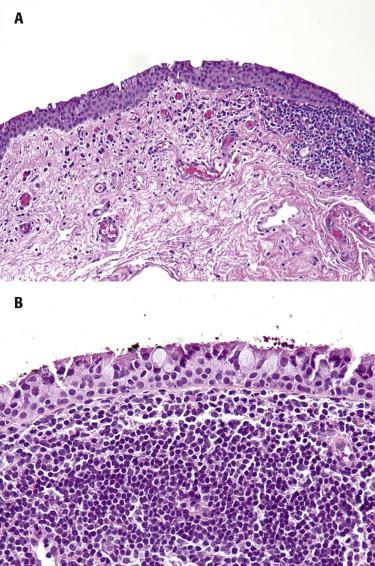
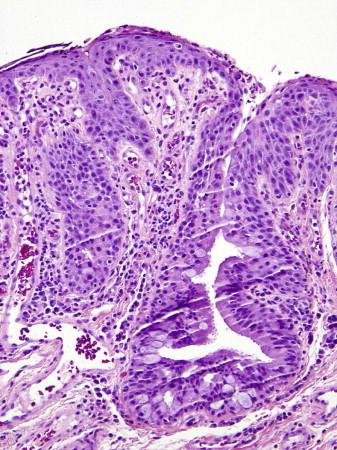
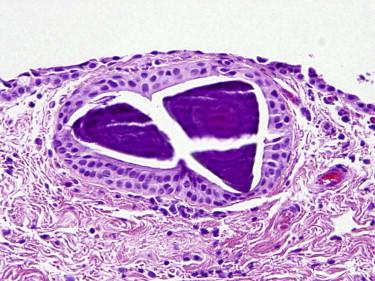
Special stains and/or cultures for microorganisms (Gram, periodic acid-Schiff with diastase digestion [PAS-D], acid fast bacilli [AFB], Fite, Steiner) may assist in the identification of infectious organisms. Direct immunofluorescence studies are indicated for the workup of an autoimmune process, such as cicatricial pemphigoid. Immunohistochemical and molecular studies can help in the differential diagnosis of pseudolymphoma from lymphoma. Serologic studies may be needed to determine whether the conjunctivitis is part of a systemic process (e.g., connective tissue disease, Wegener's granulomatosis).
The differential diagnosis is broad. The process may be localized (primary conjunctivitis) or a manifestation of systemic process. A key issue is whether a conjunctivitis may be infectious in etiology or not because this directs further treatment. Special stains and cultures are helpful in this regard. If an infectious etiology can be excluded, inflammation may reflect an allergic reaction, autoimmune disease, or chronic irritation. A plasma cell–rich conjunctivitis may lead to concerns about a low-grade B-cell lymphoma (immunocytoma or marginal zone B-cell lymphoma). Immunohistochemical studies for light chain restriction and molecular tests for B-cell clonality can help establish a definitive diagnosis.
The etiology of the conjunctivitis dictates its appropriate treatment. Viral conjunctivitis can run its course and be managed with supportive measures such as lubricants, but other infectious causes benefit from both topical and oral antibiotics. Allergic conjunctivitis is treated by avoidance of the antigen, topical and systemic antihistamines, and mast cell stabilizers. Autoimmune or autoreactive causes benefit from steroids, immunomodulatory agents, and in some instances dapsone.
Conjunctival foreign bodies can elicit focal inflammation. Similarly, a chalazion is a discrete granulomatous inflammatory lesion resulting from retained sebaceous material secreted from meibomian glands along the eyelid edge. It is also referred to as “lipogranuloma.”
Foreign body granulomas present as an elevated erythematous nodule that can incite circumscribing inflammatory reaction. Similarly, a chalazion is a discrete nontender nodule with overlying erythema and typically located close to the eyelid margin. An inspissated meibomian gland may be visualized ( Fig. 19-4 ).
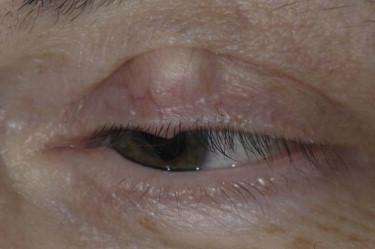
The pathology of a chalazion usually shows a nodular mixed inflammatory cell infiltrate, typically with a prominent lymphogranulomatous component reaction, but neutrophils and plasma cells may also be present ( Fig. 19-5 ). It later stages, there may be associated fibrosis.
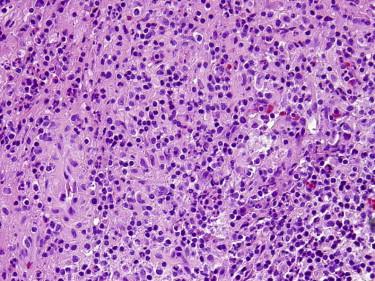
The main differential diagnosis is with an infection and foreign body reaction. Special stains (PAS-D, AFB, Fite) can help exclude an infectious etiology. Examination for polarizable material is also prudent.
Topical antiinflammatory agents can be helpful in treating the symptoms of a foreign body granuloma or chalazion. Alternatively, the granulomatous nodule can be surgically excised. The foreign body can be removed or warm compresses used to help expel the retained sebaceous material trapped in a chalazion.
The conjunctiva is an uncommon site of involvement for connective tissue disease, occurring in approximately 5% to 15% of Wegener's granulomatosis cases.
In Wegener's granulomatosis, the palpebral conjunctiva and tarsus of the upper eyelid are common sites of disease. In its inflammatory stage, the conjunctiva appears hyperemic with granulomatous or ulcerative changes. The lesion may become necrotic with an avascular appearance and surrounding conjunctival injection and may progress to a fibrovascular proliferation and fibrous scar tissue. A concomitant episcleritis or scleritis is possible. Peripheral ulcerative keratitis may also occur, with dilated perilimbal vessels, peripheral cornea thinning, and epithelial defect ( Fig. 19-6 ). Cicatricial changes can lead to alterations in eyelid architecture, including ectropion and entropion.

The histologic changes associated with Wegener's granulomatosis of the conjunctiva usually involve a lymphoid infiltrate admixed with plasma cells, histiocytes, and eosinophils ( Fig. 19-7 ). There may or may not be evidence of vascular damage. A necrotizing vasculitis is rarely seen.
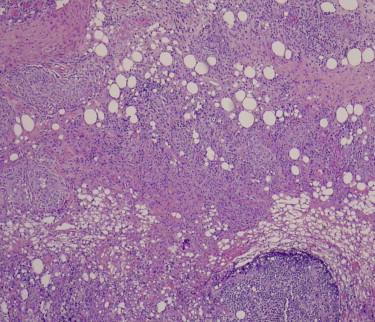
Conjunctival disease can be treated with both systemic and topical steroids and immunomodulatory agents. Epithelial defects of the cornea are covered with a topical antibiotic to prevent superinfection. An otolaryngologist should evaluate patients with conjunctival–tarsus involvement because there is an association with subglottic stenosis, which may lead to laryngeal obstruction and respiratory distress.
Prolonged exposure to ultraviolet (UV) light can result in solar damage to the conjunctiva, known as solar elastosis (and akin to actinic keratosis of the skin). Because of its predisposition from cumulative sun exposure, it is more common in individuals of advancing age.
Solar elastosis typically appears in the intrapalpebral space as a raised erythematous lesion, sometimes with yellow-white deposits (hyperkeratotic) or a pigmented appearance. Their elevated nature can disturb the tear film and result in keratoconjunctivitis.
Solar elastosis is characterized by loss of pink material and fibers on routine sections and their replacement by homogeneous grayish material ( Fig. 19-8 ).
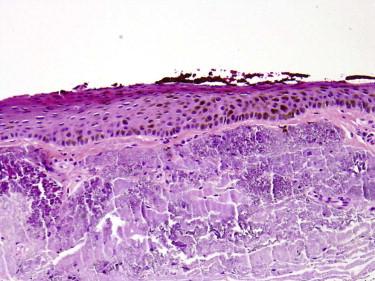
Symptoms of solar elastosis can be managed with lubricating or anti-inflammatory preparations. Given the risk of malignant transformation, these lesions can also be surgically excised. Patients should be encouraged to protect their eyes from further UV light damage with the use of sunglasses.
Both pingueculae and pterygium occur with advancing years and result from elastotic degeneration due to prolonged UV exposure ( Fig. 19-9 ).
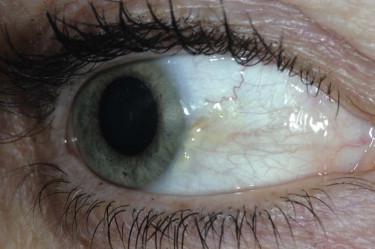
Both pingueculae and pterygium occur in the intrapalpebral space adjacent to the limbus. They typically develop over many years. They are not neoplasms but degenerative tissue alterations related to chronic sun damage. Pingueculae appear as small yellow-gray-white nodules with either an atrophic or thickened overlying epithelium. Pterygium crosses over the limbus and impinges onto the cornea in a winglike, triangular expansion ( Fig. 19-10 ). It has a thickened, fibrovascular appearance.
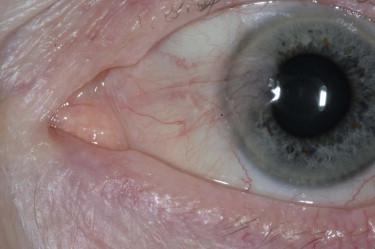
These lesions are usually not biopsied for diagnosis, but tissue may be removed surgically for symptomatic relief. The histologic findings usually reveal solar elastotic degeneration associated with nonspecific fibrosis and chronic inflammation.
Treatment of pingueculae is unnecessary because they are typically asymptomatic and show either no or little growth. As it encroaches onto the cornea, a pterygium can interrupt the tear film or induce astigmatism. In this instance, it can be surgically excised and a conjunctival autograft sutured in place to reduce the likelihood of recurrence. On rare occasions, pingueculae and pterygium can incite an inflammatory reaction, which is best treated with a course of topical antiinflammatory drops.
Conjunctival deposition of amyloid protein is a common process in healthy young and middle-aged adults without systemic amyloidosis. It is typically a primary localized entity but can less commonly result from prolonged, antecedent inflammation. It can also occur as an ophthalmic manifestation of systemic disease, such as multiple myeloma or lymphoma.
Amyloid deposition presents as a nodular or diffuse rubbery, waxy thickening of the conjunctiva ( Fig. 19-11 ). It has a yellow-orange appearance and clings in a perivascular fashion. Whereas palpebral deposits usually signify a localized pathology, eyelid involvement is more commonly a systemic manifestation.
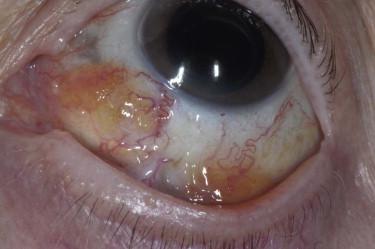
Amyloid material manifests on routine sections as hyaline amorphous pink material ( Fig. 19-12 ).
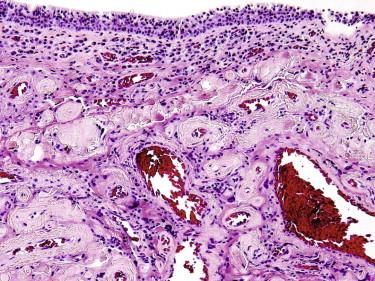
Special stains (toluidine blue, Congo red) can assist in documenting the presence of amyloid.
Extensive, thickened deposition can disrupt the tear film and benefit from topical lubrication. Instances of larger, cosmetically undesirable lesions can be surgically excised.
Retention cysts of the conjunctiva are common and asymptomatic and previous surgery can be a predisposing feature.
Cysts appear as thin-walled, clear fluid-filled elevations more commonly on the palpebral conjunctiva ( Fig. 19-13 ). They can form large solitary lesions or small cysts may form confluent clusters.
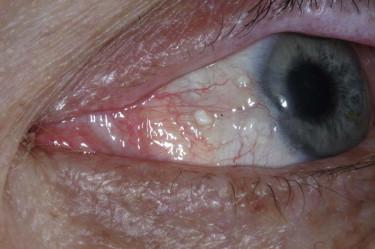
Conjunctival cysts are lined by conjunctival-type mucosa, including columnar epithelium and goblet cells. Squamous metaplasia may be present. They usually appear as cystic invaginations of the surface mucosa in the superficial subepithelial stroma ( Fig. 19-14 ).
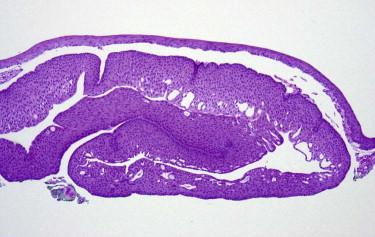
Because of their asymptomatic nature, cysts often require no treatment. However, they can be lanced by needle puncture to expel the fluid contents, but they may recur thereafter.
Squamous papillomas are benign epithelial proliferations usually related to human papillomavirus (HPV; conjunctival warts). They may be pedunculated or sessile. Pedunculated lesions tend to occur in children and young adults, most often located inferiorly in the fornix. Sessile lesions are more common in the bulbar conjunctiva of adults. They present as grayish red soft lesions, may be multifocal, are associated with irritation and inflammation, and impair visual acuity.
Lesions are characterized by papillomatous epithelial hyperplasia. Multiple branching fronds may emanate from a fibrovascular core ( Fig. 19-15 ). Pedunculated lesions have a narrow stalk, sessile lesions, and a broad base. The epithelium is usually composed of nonkeratinizing squamous epithelium with variable number of admixed goblet cells. The fibrous cores are usually hypervascular with many ectatic vessels. Cytologic atypia is usually absent. HPV cytopathic changes (koilocytes, binucleated cells, raisinoid nuclei) may or may not be present.
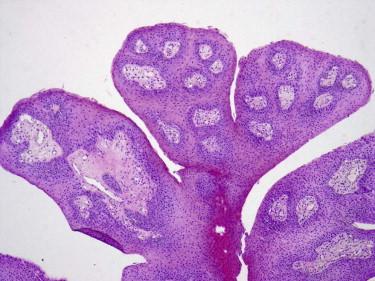
Symptomatic lesions are usually surgically removed. Similar to cutaneous warts, lesions may recur after local destruction or surgical removal.
Ocular surface squamous neoplasia consists of corneal/conjunctival intraepithelial neoplasia (CCIN) and squamous cell carcinoma (SCC). Its incidence is between 0.2 and 20 cases per million and varies geographically, with some of the highest rates in Africa. The incidence in the United States is approximately 1/10 6 . Risk factors include older age, UV or toxin exposure, immunosuppression, HPV infection, male gender, and fair skin.
Depending on geographic area, 0.3 to 20/10 6
Older age
Male white individuals
Chronic ultraviolet exposure
History of smoking
Human papillomavirus
Immunosuppression
Exposure to toxic compounds
DNA repair defects
Sessile, fleshy, elevated lesion
Leukoplakia
Erythematous conjunctivitis-like
Become a Clinical Tree membership for Full access and enjoy Unlimited articles
If you are a member. Log in here